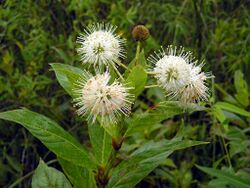Biology:Cephalanthus
| Cephalanthus | |
|---|---|

| |
| Cephalanthus occidentalis | |
| Scientific classification | |
| Kingdom: | Plantae |
| Clade: | Tracheophytes |
| Clade: | Angiosperms |
| Clade: | Eudicots |
| Clade: | Asterids |
| Order: | Gentianales |
| Family: | Rubiaceae |
| Subfamily: | Cinchonoideae |
| Tribe: | Naucleeae |
| Genus: | Cephalanthus L. |
| Type species | |
| Cephalanthus occidentalis | |
| Synonyms | |
Cephalanthus is a genus of flowering plants in the family Rubiaceae. There are about six species that are commonly known as buttonbush.[1][2]
Description
They are shrubs or small trees growing to 5–15 m (16–49 ft) tall. The leaves are simple, arranged in opposite pairs or whorls of three. The flowers form a dense globular inflorescence.
Distribution and habitat
Cephalanthus occidentalis is native to the eastern United States and Canada . The others occur in tropical regions of the Americas, Africa and Asia.[3] Two species are known in cultivation.[4]
Systematics
Cephalanthus was named by Linnaeus in Species Plantarum in 1753.[5] The generic name is derived from the Ancient Greek words κέφαλη (kephale), meaning "head", and ἄνθος (anthos), meaning "flower".[6]
Taxonomy
Cephalanthus is the most basal genus in the tribe Naucleeae.[7] Some authors have segregated it into its own monotypic tribe.[8] The type species is Cephalanthus occidentalis.[9]
Species
- Cephalanthus angustifolius Lour. - Laos, Cambodia, Vietnam
- Cephalanthus glabratus (Spreng.) K.Schum. - sarandí - Brazil , Argentina , Paraguay, Uruguay
- Cephalanthus natalensis Oliv. - Tanzania, Malawi, Zambia, Lesotho, Eswatini, South Africa
- Cephalanthus occidentalis L. - button-willow, common buttonbush, honey-bells - Cuba, eastern Canada , eastern, central and southern United States , California , Arizona, New Mexico
- Cephalanthus salicifolius Humb. & Bonpl. - Mexican buttonbush, willowleaf buttonbush - Mexico, Honduras, extreme southern tip of Texas
- Cephalanthus tetrandrus (Roxb.) Ridsdale & Bakh.f.[2][10][11] - tropical Asia from India to China and Thailand
Fossil record
16 fossil mericarps of †Chephalanthus pusillus have been described from middle Miocene strata of the Fasterholt area near Silkeborg in Central Jutland, Denmark .[12]
References
- ↑ The Plant List, Cephalanthus
- ↑ 2.0 2.1 Flora of China, Cephalanthus
- ↑ Mabberley DJ (2008). Mabberley's Plant Book (3rd ed.). Cambridge University Press. ISBN 978-0-521-82071-4.
- ↑ Huxley AJ et al. (eds.) The New Royal Horticultural Society Dictionary of Gardening. The Macmillan Press Limited, London; The Stockton Press, New York. 1992. ISBN:978-0-333-47494-5
- ↑ Linnaeus, C. Cephalanthus. Species Plantarum. 1753. 1: 95
- ↑ Quattrocchi, U. (2000). CRC World Dictionary of Plant Names. 1. Boca Raton, New York, Washington DC, London: CRC Press. pp. 476. ISBN 978-0-8493-2675-2. https://books.google.com/books?id=A68qyOyhOdkC&q=Cephalanthus&pg=PA476.
- ↑ Manns, U. and B. Bremer. 2010. Towards a better understanding of intertribal relationships and stable tribal delimitations within Cinchonoideae s.s. (Rubiaceae). Molecular Phylogenetics and Evolution 56(1), 21-39. doi:10.1016/j.ympev.2010.04.002
- ↑ Ridsdale CE (1976). "A revision of the tribe Cephalantheae (Rubiaceae)". Blumea 23 (1): 177–88.
- ↑ Cephalanthus. Index Nominum Genericorum. Smithsonian National Museum of Natural History.
- ↑ "Cephalanthus tetrandrus (Roxb.) Ridsdale & Bakh.f.". June 2023. https://wfoplantlist.org/plant-list/taxon/wfo-0000830136-2023-06?page=1.
- ↑ "Cephalanthus tetrandrus (Roxb.) Ridsdale & Bakh.f.". Royal Botanic Gardens, Kew. https://powo.science.kew.org/taxon/urn:lsid:ipni.org:names:746238-1.
- ↑ Angiosperm Fruits and Seeds from the Middle Miocene of Jutland (Denmark) by Else Marie Friis, The Royal Danish Academy of Sciences and Letters 24:3, 1985
External links
- Kew World Checklist of Selected Plant Families, Cephalanthus
- USDA PLANTS, Cephalanthus
- Flora of Taiwan, Cephalanthus
Wikidata ☰ Q3245386 entry
 |

